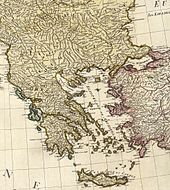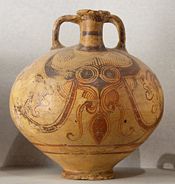- Helladic period
-
History of Greece 
This article is part of a seriesGreek Bronze Age Helladic civilization Cycladic civilization Minoan civilization Mycenaean civilization Ancient Greece Greek Dark Ages Archaic Greece Classical Greece Hellenistic Greece Roman Greece Medieval Greece Byzantine Greece Frankish and Latin states Ottoman Greece Modern Greece War of Independence Kingdom of Greece Second Hellenic Republic 4th of August Regime Axis occupation Civil War Military Junta Third Hellenic Republic History by topic Art · Constitution · Economy · Military · Names
Greece Portal
Helladic is a modern archaeological term meant to identify a sequence of periods characterizing the culture of mainland ancient Greece during the Bronze Age. The term is commonly used in archaeology and art history. It was intended to complement two parallel terms, Cycladic, identifying approximately the same sequence with reference to the Aegean Bronze Age, and Minoan, with reference to the civilization of Crete.
The scheme applies primarily to pottery and is a relative dating system. The pottery at any given site typically can be ordered into early, middle and late on the basis of style and technique. The total time window allowed for the site is then divided into these periods proportionately. As it turns out, there is a correspondence between "early" over all Greece, etc. Also some "absolute dates" or dates obtained by non-comparative methods can be used to date the periods.
Absolute dates are preferable whenever they can be obtained. However, the relative structure was devised before the age of carbon dating. Most of the excavation was performed then as well. Typically only relative dates are obtainable. They form a structure for the characterization of Greek prehistory. Objects are generally dated by the pottery of the site found in associative contexts. Other objects can be arranged into early, middle and late as well, but pottery is used as a marker.
The three terms Helladic, Cycladic, and Minoan refer to location of origin. Thus Middle Minoan objects might be found in the Cyclades, but they are not on that account Middle Cycladic. The scheme tends to be less applicable in areas on the periphery of the Aegean, such as the Levant. Pottery there might imitate Helladic or Minoan and yet be locally manufactured.
Contents
Periodization
The "early", "middle" and "late" scheme can be applied at different levels. Rather than use such cumbersome terms as "early early" archaeologists by convention use I, II, III for the second level, A, B, C for the third level, 1, 2, 3 for the fourth level and a, b, c for the fifth. Not all levels are present at every site. If additional levels are required, another "early", "middle" or "late" can be appended. The Helladic period is subdivided as:
Period Approximate Date Early Helladic I 2800-2500 Early Helladic II 2500-2300 Early Helladic III 2300-2100 Middle Helladic 2100-1550 Late Helladic I 1550-1500 Late Helladic II 1500-1400 Late Helladic III 1400-1060 Early Helladic (EH)
Further information: Aegean civilization and Proto-GreekThe Early Helladic is characterized by an agricultural population who used basic techniques of bronze-working first developed in Anatolia with which they had cultural contacts. Their emergence is the beginning of the Bronze Age in Greece. The Early Helladic period corresponds in time to the Old Kingdom in Egypt. Important Early Helladic sites are clustered on the Aegean shores of the mainland in Boeotia and Argolid (Lerna, Pefkakia, Thebes, Tiryns) or coastal islands such as Aegina (Kolonna) and Euboea (Lefkandi, Manika) and are marked by pottery showing Western Anatolian influences and the introduction of the fast-spinning version of the potter's wheel. The large "longhouse" called a megaron is introduced in EH II. The infiltration of Anatolian cultural models was not accompanied by widespread site destruction.
Middle Helladic (MH)
Further information: Minyans and Origin of the GreeksIn Greece, the Middle Helladic period begins with the wide-scale emergence of the Minyan Ware, which may be directly related to the people whom ancient Greek historians called Minyans; a group of monochrome burnished pottery from Middle Helladic (and EH III) sites was conventionally dubbed "Minyan" ware by Troy's discoverer Heinrich Schliemann. Until about 1960, Gray Minyan ware was often[dubious ] identified as the pottery introduced by a Middle Bronze Age migration.[1]; excavations at Lerna have revealed the development of pottery styles to have been continuous. In general, painted pottery decors are rectilinear and abstract until Middle Helladic III, when Cycladic and Minoan influences inspire a variety of curvilinear and even representational motifs.
The Middle Helladic period corresponds in time to the Middle Kingdom of Egypt. Settlements draw more closely together and tend to be sited on hilltops. Middle Helladic sites are located throughout the Peloponnese and central Greece (including sites in the interior of Aetolia such as Thermon) as far north as the Spercheios River valley. Malthi in Messenia is the only Middle Helladic site to have been thoroughly excavated, but Lerna V will be the type site when it is fully published (Rutter).
Late Helladic (LH)
The Late Helladic is the time when Mycenaean Greece flourished, under new influences from Minoan Crete and the Cyclades. Those who made LH pottery sometimes inscribed their work with a syllabic script, Linear B, which has been deciphered as Greek. LH is divided into I, II, and III; of which I and II overlap Late Minoan ware and III overtakes it. LH III is further subdivided into IIIA, IIIB, and IIIC. The table below provides the approximate dates of the Late Helladic phases (LH) on the Greek Mainland.
Period Approximate Date LHI 1550-1500 LHIIA 1500-1450 LHIIB 1450-1400 LHIIIA1 1400-1350 LHIIIA2 1350-1300 LHIIIB1 1300-1230 LHIIIB2 1230-1190 LHIIIC (Early) 1190-1130 LHIIIC (Middle) 1130-1090 LHIIIC (Late) 1090-1060 Sub-Mycenean 1060-1000 Protogeometric 1000 Late Helladic I (LHI)
The LHI pottery is known from the fill of the shaft graves of Lerna and the settlements of Voroulia and Nichoria (Messenia), Ayios Stephanos, (Laconia) and Korakou. Furumark divided the LH in phases A and B, but Furumark's LHIB has been reassigned to LHIIA by Dickinson. Some recent C-14 dates from the Tsoungiza site north of Mycenae indicate LHI there was dated to between 1675/1650 and 1600/1550 BC, which is earlier than the assigned pottery dates by about 100 years. The Thera eruption also occurred during LHI (and LCI and LMIA), variously dated within the 1650-1625 BC span.
Not found at Thera, but extant in late LHI from Messenia, and therefore likely commencing after the eruption, is a material culture known as "Peloponnesian LHI".[2] This is characterised by "tall funnel-like Keftiu cups of Type III"; "small closed shapes such as squat jugs decorated with hatched loops ('rackets') or simplified spirals"; "dark-on-light lustrous-painted motifs", which "include small neat types of simple linked spiral such as varieties of hook-spiral or wave-spiral (with or without small dots in the field), forms of the hatched loop and double-axe, and accessorial rows of small dots and single or double wavy lines"; and also the "ripple pattern" on "Keftiu" cups. These local innovations continued into the LHIIA styles throughout the mainland.
Late Helladic II (LHII)
The description of the LHIIA is mainly based on the material from Kourakou East Alley. Domestic and Palatial shapes are distinguished. There are strong links between LHIIA and LMIB. LHIIB began before the end of LMIB, and sees a lessening of Cretan influences. Pure LHIIB assemblages are rare and originate from Tiryns, Asine and Korakou. C-14 dates from Tsoungiza indicate LHII was dated to between 1600/1550 and 1435/1405 BC, the start of which is earlier than the assigned pottery date by about 100 years, but the end of which nearly corresponds to the pottery phase. In Egypt, both periods of LHII correspond with the beginning of its "Imperial" period, from Hatshepsut to Tuthmosis III.
Late Helladic III (LHIII)
LHIII and LMIII are contemporary. Toward LMIIIB, non-Helladic ware from the Aegean ceases to be homogeneous; insofar as LMIIIB differs from Helladic, it should at most be considered a "sub-Minoan" variant of LHIIIB.
The uniform and widely spread LHIIIA:1 pottery was originally defined by the material from the Ramp house at Mycenae, the palace at Thebes (now dated to LHIIIA:2 or LHIIIB by most researchers) and Triada at Rhodes. There is material from Asine, Athens (wells), Sparta (Menelaion), Nichoria and the 'Atreus Bothros', rubbish sealed under the Dromos of the Treasury of Atreus at Mycenae as well. C-14 dates from Tsoungiza indicate LHIIIA:1 should be more nearly 1435/1406 to 1390/1370 BC, slightly earlier than the pottery phase, but by less than 50 years. LHIIIA:1 ware has also been found in Maşat Höyük in Hittite Anatolia.[3]
The LHIIIA:2 pottery marks a Mycenaean expansion covering most of the Eastern Mediterranean. There are many new shapes. The motifs of the painted pottery continue from LHIIIA:1 but show a great deal of standardization. In Egypt, the Amarna site contains LHIIIA:1 ware during the reign of Amenhotep III and LHIIIA:2 ware during that of his son Akhenaten; it also has the barest beginnings of LHIIIB. LHIIIA:2 ware is in the Uluburun shipwreck, which sank in the 14th century BCE. Again, Tsoungiza dates are earlier, 1390/1370 to 1360/1325; but LHIIIA:2 ware also exists in a burn layer of Miletus which likely occurred early in Mursilis II's reign and therefore some years prior to Mursili's eclipse in 1312 BCE. The transition period between IIIA and IIIB begins after 1320 BCE, but not long after (Cemal Pulak thinks before 1295 BCE).
The definition of the LHIIIB by Furumark was mainly based on grave finds and the settlement material from Zygouries. It has been divided into two sub-phases by Elizabeth B. French, based on the finds from Mycenae and the West wall at Tiryns. LHIIIB:2 assemblages are sparse, as painted pottery is rare in tombs and many settlements of this period ended by destruction, leaving few complete pots behind.
LHIIIB pottery is associated in the Greek mainland palaces with the Linear B archives. (Linear B had been in use in Crete since Late Minoan II.) Pulak's proposed LHIIIA/B boundary would make LHIIIB contemporary in Anatolia with the resurgent Hittites following Mursili's eclipse; in Egypt with the 19th Dynasty, also known as the Ramessides; and in northern Mesopotamia with Assyria's ascendancy over Mitanni. The end of LHIIIB is associated with the destruction of Ugarit, whose ruins contain the last of that pottery. The Tsoungiza date for the end of LHIIIB is 1200/1190. The beginning of LHIIIC, therefore, is now commonly set into the reign of Queen Twosret. The LHIIIC has been divided into LHIIIC:1 and 2 by Furumark, based on materials from tombs in Mycenae, Asine, Kephalonia and Rhodes. In the 1960s, the excavations of the Citadel at Mycenae and of Lefkandi in Euboea yielded stratified material that allowed the ss. There is a lot of regional variation in the LHIIIC, especially in the later phases. Late LHIIIC pottery is found in Troy VIIa and a few pieces in Tarsus. It was also made locally in the Philistine settlements of Ashdod, Ashkelon, Ekron, Gath, and Gaza.
References
- ^ Mellaart, James (January 1958). "The end of the early Bronze Age in Anatolia and the Aegean". American Journal of Archaeology 62 (1): 3.
- ^ Lolos, Y.G. (1989). On the Late Helladic I of Akrotiri, Thera. In Thera and the Aegean World III. Volume Three: Chronology. Proceedings of the Third International Congress, Santorini, Greece, 3-9 September 1989. Thera Foundation. Retrieved 4 September 2008.
- ^ Kuniholm, P. (1998). Aegean Dendrochronology Project December 1996 Progress Report. Cornell Tree-Ring Laboratory, Cornell University. Retrieved 4 September 2008.
See also
- Aegean civilization
- Cyclades
- History of Greece
- Linear B
- Minoan civilization
- Mycenaean Greece
- Mycenaean language
- Pelasgians
External links
- Images of artifacts and sites of Helladic Greece
- Jeremy B. Rutter, Dartmouth College, "Prehistoric Archeology of the Aegean:" especially chapters 3, 8, 9.
- Aegean and Balkan Prehistory: Articles, site-reports and bibliography database concerning the Aegean, Balkans and Western Anatolia
Categories:- Aegean civilizations
- Mycenaean Greece
- Historical eras
Wikimedia Foundation. 2010.

